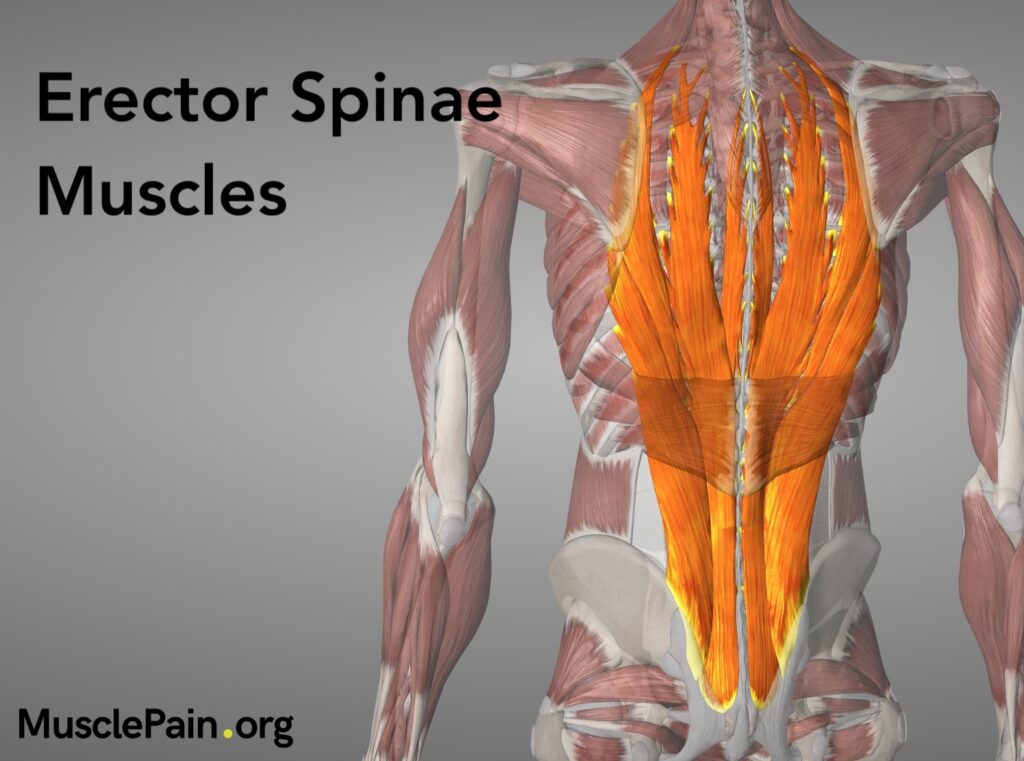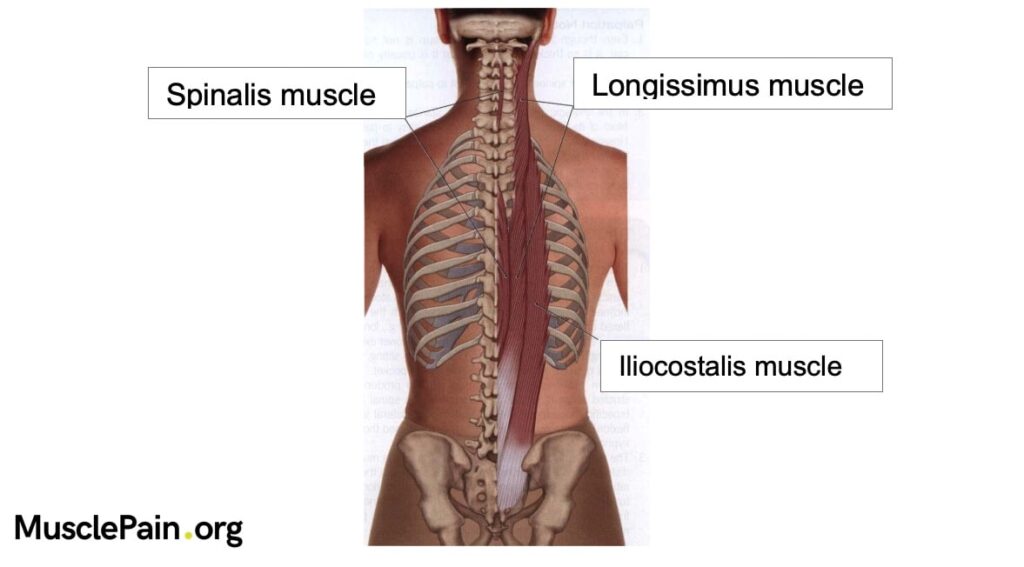Introduction
The erector spinae, also called sacrospinalis, comprises three paralleled muscles known as the iliocostalis, longissimus and spinalis which are arranged from lateral to the medial.(1)
These superficial spinal muscles are composed of small, paired muscle fibers and tendons that lined up straight next to the spine extending from the skull to the lower aspect of the spine.(2)
The muscle runs the full length of the vertebra, and pain may refer from between the shoulder blades upwards into the shoulder and chest or downwards into the buttocks. Activities that aggravate the pain include straining to lift objects and movements that combine bending and twisting of the trunk.
Prolonged sitting and standing without relaxation can also aggravate the pain. The muscle produces lateral flexion and rotation to the opposite side when used unilaterally, and helps to extend the spine when used bilaterally. It may also be used as an accessory muscle for respiration.
List of muscles of the erector spinae
- Iliocostalis:
- Iliocostalis cervicis
- Iliocostalis thoracis
- Iliocostalis lumborum
- Longissimus:
- Longissimus capitis
- Longissimus cervicis
- Longissimus thoracis
- Spinalis:
- Spinalis capitis
- Spinalis cervicis
- Spinalis thoracis
The muscle groups are organized laterally to medially, with iliocostalis being the most lateral, longissimus in the middle, and spinalis being the most medial.
Each muscle group has subcategories: capitis, cervicis, thoracis, and lumborum. The names of these subcategories indicate where the muscles insert.
For example, capitis muscles insert on the skull, cervicis muscles insert on the cervical vertebrae, thoracis muscles insert on the thoracic vertebrae, and lumborum muscles insert on the lumbar vertebrae.

Anatomy
Origin
Iliocostalis muscle origin includes the sacral bone, iliac crest, spinous processes of the lumbar spinal column, thoracolumbar fascia, and costal angle. Longissimus muscle origin includes the transverse processes of the lumbar vertebrae (L1–L5), sacral bone, iliac crest, spinous and mammillary processes of the lumbar spinal column.
Spinalis muscle found only in the middle of the back, it origins from the spinous processes of the spinal column.(3)
Insertion
Iliocostalis muscle inserts to the cranial and caudal at the transverse processes of the middle cervical spinal column or rib angles for the lumbar and thoracic area. Longissimus muscle insertion is on the transverse processes of all thoracic vertebrae, mastoid process, costal and accessory process of ribs 2- 12.(3,4)

Innervation
The nerve supply for all erector spinae muscle group is from the dorsal branches of the segmental spinal nerves.(3)
Action
The function of erector spinae is to maintain upright posture and to move and protect the spinal column. When these muscles work bilaterally they straighten the back and extend the spine; when acting unilaterally they laterally bend the torso to the same side synergistically with the abdominals muscle.(4,5) They can also ipsilaterally rotates the trunk, neck, and head at the spinal joints.(6)
Additionally, they help with exhalation, straining to have bowel movements, coughing, and sneezing. By eccentrically contracting i.e. contracting and lengthening at the same time these muscles function to checkrein the body when bending forward or to one side.(7)
Trigger Points
Trigger points in the superficial spinal muscles usually cause a more diffuse
kind of pain than trigger points in the deep spinal muscles. Trigger points in the longissimus and the spinalis are found within a couple inches of the spine and send their pain generally downward to the low back and buttocks. Iliocostalis trigger points are found about three inches from the spine and send their pain both upward and downward and a little more to the side.(7)
Satellite trigger points: Each muscle of the erector spinae group may develop satellite trigger points in response to the presence of trigger points in any other muscle of the group. Additional trigger points might also be found in the latissimus dorsi and quadratus lumborum muscles.
Pain Pattern
Iliocostalis thoracis: pain in the thoracic region of the back and sometimes the abdomen, with restriction of spinal motion. It also radiates to cranial into the shoulder area and into the lateral chest wall.(4)(3)
Iliocostalis lumborum: pain is referred downward, low in the buttock and along the iliac crest. (4)
Longissimus thoracis: pain is referred low in the buttock. When trigger points are located bilaterally at the level of L1, the patient will have difficulty rising from a chair and/or climbing stairs. It also radiates to and the iliosacral joint (IS]) region.(3)
Spinalis: The pain is concentrated around the trigger point.(3)


Figure 2: Trigger points and pain pattern of erector spinae muscle. (Source: The Concise Book of Trigger Points, Chapter 5, Page 75)
Perpetuating factors
Sudden overload through improper lifting; sustained overload resultant from postural stresses (hyperlordosis); immobility for extended periods of time.
Bending forward from the hips to lift an object from the floor, rather than reaching from bent knees, places a excessive load on these muscles.
Straining to have a bowel movement and coughing also produce a strong contraction of erector spinae.
The erector spinae is in a continual state of contraction in the person who has a strongly arched low back.(4)(5)
Exercises
Fixing Muscle Tightness
a. Use a tennis ball, spiky massage ball, or soft dog toy for self-massage.
b. Target tight spots and massage them against a wall or use a pillowcase to easily reach middle and upper back areas.
Lengthening the Muscles
a. Perform seated stretches in a chair, focusing on the upper and middle back first. Round the back into flexion and rotate to stretch the muscles.
b. For the lower back, bend forward while seated, placing your hands on the back of your head and rounding your back.
Strengthening the Muscles
a. Superman Exercise – Lie on your stomach and lift your head, shoulders, and arms upwards. Progress from simple to more challenging variations, such as lifting the feet and extending the arms forward.
b. Hip Extension off the Side of a Bed – Lie on your stomach with hips and legs off the edge of a bed. Lift one leg at a time, focusing on activating the glutes and lower back muscles. Progress to lifting both legs simultaneously.
Other exercises
Incorporating these stretches into your daily routine can help improve flexibility, reduce back pain, and promote better overall spinal health.
1. Cat/Camel Stretch
The Cat/Camel stretch is an excellent way to begin stretching your Erector Spinae muscles. To perform this stretch:
- Start on all fours, with your hands under your shoulders and your knees under your hips.
- Tuck your chin in and arch your back, creating a curve.
- Hold this position for 3 seconds and repeat 10 times or hold for 30 seconds and repeat 3 times.
- Remember to tuck your chin, as this helps create the curve needed to stretch the muscles effectively.
2. Double Knee-to-Chest Stretch with Chin Tuck
The double knee-to-chest stretch targets your lower back muscles while the chin tuck adds emphasis to the Erector Spinae. To perform this stretch:
- Lie on your back and pull both knees towards your chest.
- Grasp your knees either on top or beneath them, depending on your knee health and comfort.
- Tuck your chin in while pulling your knees towards you.
- Hold this position for 30 seconds and repeat 3 times.
- Optional: Gently rock back and forth to increase the stretch.
3. Rotational Stretch
The rotational stretch targets the Erector Spinae muscles while also improving spinal mobility. To perform this stretch:
- Sit on the floor with your legs extended in front of you.
- Cross the leg of the side you want to stretch over the other leg.
- Turn towards the crossed leg and place your elbow on the outside of the knee.
- Gently apply pressure with your elbow to increase the stretch.
- Hold this position for 30 seconds and repeat 3 times.
Conclusion
Incorporating these Erector Spinae muscle stretches into your daily routine can help improve flexibility, reduce back pain, and promote better overall spinal health. Remember to always prioritize safety and listen to your body when performing any stretching exercises.
References
1. Niel-asher S. The Concise Book of Trigger Points. 2nd edition. 2008.
2. Starlanyl DJ, Sharkey J. Healing through trigger point therapy – a guide to fibromyalgia, myofascial pain and dysfunction. Vol. 15. 2016.
3. Richler P, Hebgrn E. Trigger Points and Muscle Chains in Osteopathy. 2009.
4. Finando D, Finando S. Trigger Point Therapy for Myofascial Pain. 2005.
5. Finando D, Ac L. Trigger Point Self-Care Manual- For Pain-Free Movement. Inner Traditions / Bear & Company; 2005.
6. Muscolino JE. The Muscle and Bone Palpation Manual with Trigger Points, Referral Patterns and Stretching. 2009.
7. Claire Davies AD. The Trigger Point Therapy Workbook- Your Self-Treatment Guide for Pain Relief. 2013.
MD, PhD. Physical Medicine & Rehabilitation Physician from São Paulo - Brazil. Pain Fellowship in University of São Paulo.

